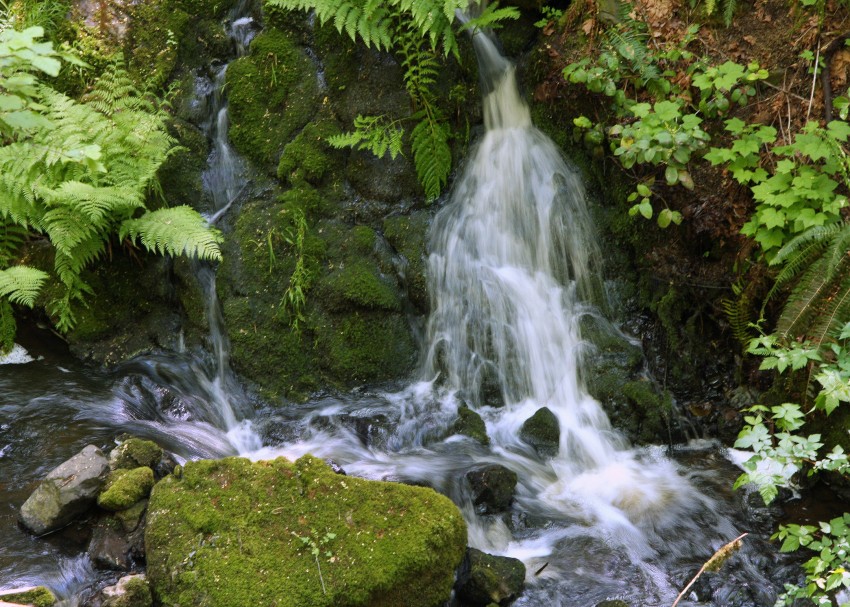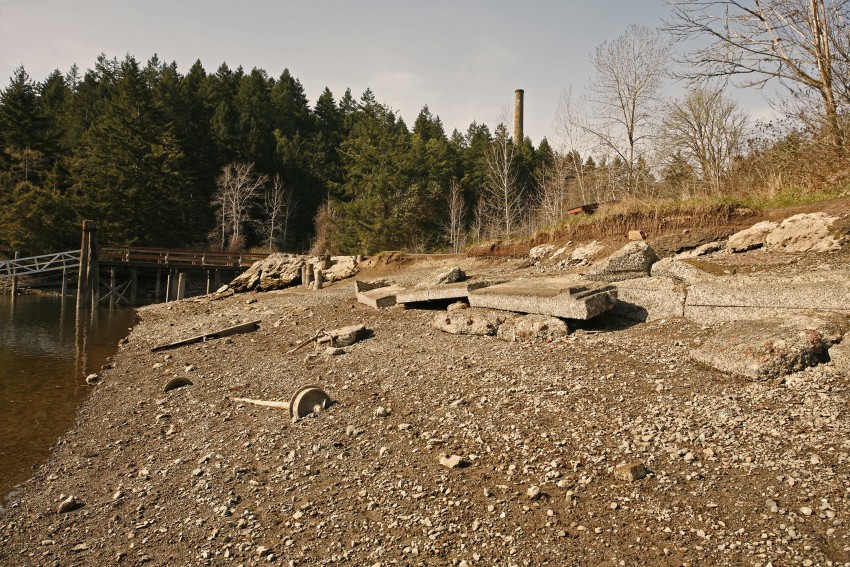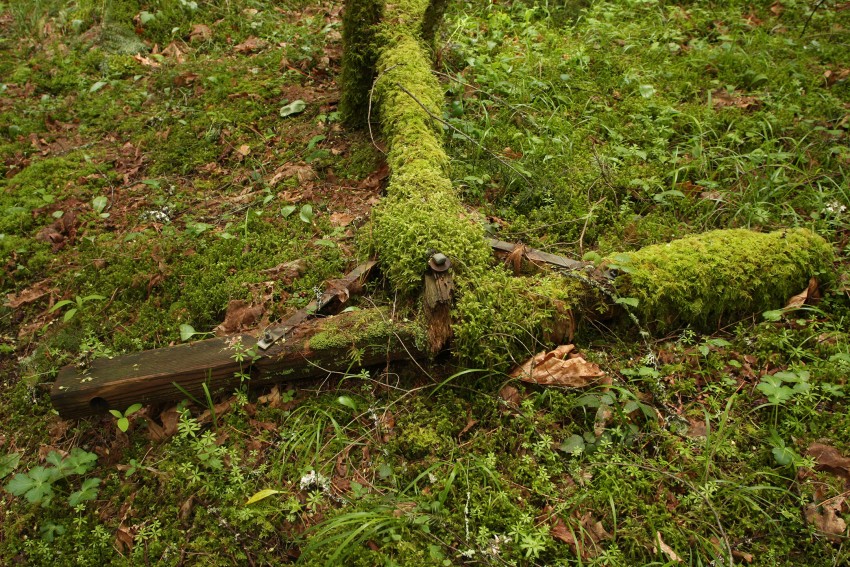#36 Eelgrass, cement and serenity
November 04th, 2016
REVIEW: Tod Inlet: A Healing Place
By Gwen Curry
Victoria: Rocky Mountain Books, 2015. $25. ISBN 9781771600767
Reviewed by Peter Grant
*
Shortlisted for the 2016 Roderick Haig-Brown Regional Prize, Gwen Curry’s first book, Tod Inlet: A Healing Place, joins a burgeoning, British Columbian literature of place—once more an environmental vision conceived in love extends into a mission of advocacy.
Tod Inlet is a two-kilometre-long reach of Saanich Inlet near Brentwood Bay on southern Vancouver Island. It borders the little peninsula occupied by The Butchart Gardens.
The much-altered sylvan surroundings are easily approached by trails that have been the frequent resort of Gwen Curry, who lives nearby. A retired professor of Visual Arts at the University of Victoria, she has documented Tod Inlet with more than 180 of her colour photos to showcase both distinctive aesthetics and history.
For decades Tod Inlet has been a popular place to moor boats and all too often to abandon them. The inlet was the site of a cement factory, shipping docks, a tile and pot factory, a village that subsisted for some fifty years, and a shantytown of Chinese workers.
Remnants of a varied past are everywhere, or hidden underground or else dispersed among collectors. The inlet’s intense and compressed industrial history is not, however, Curry’s primary focus for Tod Inlet: A Healing Place.
The restoration of ecological health to the inlet is reflected in the foreword and in an endorsement by Nikki Wright of the SeaChange Marine Conservation Society, whose admirable goal is to repopulate the fantastically beneficial eelgrass (among other flora) in Tod Inlet and throughout the shallows of the Salish Sea. As the book documents, the disappearance of eelgrass is far from the only ecological challenge in that place, and SeaChange is far from the only agent addressing its challenges.
Curry presents her celebration of place in a seasonal sequence. It’s a common form of the genre. And it is where the book falls short, from an historian’s perspective. The history of the place is relegated to sidebars scattered throughout the narratives of Curry’s visits at different times of the year.
Curry acknowledges that she took on the challenge of presenting its history belatedly: “Six years ago, I began a photographic homage to the inlet and its surroundings. Initially, its beauty and serenity were all I needed to keep me focused on my project, but its history kept intruding and I finally began to tell its story.”
The historical narrative should help us understand the particulars of the place revealed in Curry’s photographs. I adduce a couple of examples to show some gaps. We all know that the famous Sunken Garden at The Butchart Gardens was a limestone quarry. And that Jennie Butchart hung down the sides of the exhausted quarry in a bosun’s chair, stuffing plants into the crevices, making it a garden people travel from all over the world to see.
What is not so obvious is that the cement plant (1904-1921) was right beside the quarries, and the docks right beside the plant. I wished for a map to accompany the relevant text, even a locator map to give the inlet geographic context. A couple of historical photos would reveal the proximity of the cement plant to the workers’ communities and the Butchart estate. The three aerial photos in the book do little to fill that gap.
The theme of ecosystem regeneration would be enriched by detailing the nature and scale of the cement manufacturing operation and its effects on the environment and, by inference, on the workers and their families. Curry might have consulted the process of making portland cement described at Tod Inlet by T.W. Paterson and Garnet Basque in their Ghost Towns and Mining Camps of Vancouver Island (Heritage House, 2003). The heart of the operation was a rotary kiln where the mixture of lime, clay, gypsum, and water was roasted at a temperature of 1480ºC/2700ºF.
A detailed description of the cement works comes belatedly in the last section, where a memoir of limestone quarrying is the topic of a nine-paragraph block quote.
A high smokestack — all that now survives of the cement plant — was a primitive attempt to deal with the seriously toxic emissions from the gasified coal that fuelled the kilns. A powdery alkaline dust coated everything within a mile — as, closer to the present day, the upper Malahat was coated with white dust from the nearby cement plant at Bamberton. It was a dirty business.
A companion analysis to Tod Inlet is the recent documentary film by David Gray, Beyond the Gardens’ Wall (2011), which tells the unknown story of immigrant workers at the quarry from China and India. Gray’s film can be viewed online, and I would draw the viewer’s attention especially to the aerial photo of the industrial site at 4:45.
Beginning in the 1970s, a succession of developers proposed various mixes of residential, commercial, and recreational use; the Tsartlip First Nation lodged a land claim; the municipality of Saanich included Tod Creek watershed in its community planning process; and a number of environmental protection groups rose up to defend the inlet and its surroundings, culminating in the designation of Gowlland-Tod Provincial Park in 1995.
This later history of Tod Inlet, in Curry’s Summer section, is a bit shy of tracing the interrelationships, whether causal or synchronous, between the many forces in play. One wishes for a chronology that would integrate all the players. It would be interesting to know, for example, the role of provincial and local politics in the establishment of the park.
The inclusion here of an historical overview of the Tod Creek Flats — which is ecologically related, having been dammed and ditched, polluted with runoff from farms and effluent from landfill, all of which ended up in shallow, warmish, sluggish Tod Inlet — is questionable if only because the larger watershed is nowhere part of Curry’s photo essay.
Some errors of fact hint that Curry is not always on solid ground when discussing history. She notes that a Chinese worker “arrived in Canada in 1912 aboard a ship that was supplying construction workers for the Canadian Pacific Railway. No doubt becoming appalled at the number of his fellow countrymen who were dying on the railway, he made his way westward.…” (120). Surely the reference here is to the construction of the British Columbia section of the CPR in the 1880s.
Then again, “In 1911 the Chinese of Victoria numbered 3,458 — about half the population of the city at that time….” (124). The 1911 census — available in two volumes online — shows Victoria’s population (including, apparently, Oak Bay) at 31,660, Esquimalt at 5,919, and Saanich with 6,026 people.
That said, this thoughtful book adds to our storehouse of knowledge about southern Vancouver Island and its vibrant, varied, and diverse industrial and ecological history.
And thanks to Curry’s photos, Tod Inlet is also an attractive record of a most beautiful inlet and of one person’s experience in a special corner of what the epigrammatic James Douglas called a “Perfect Eden.”
*
Peter Grant is the author of seven books about Vancouver Island (Victoria a History in Photographs; Wish You Were Here, Life on Vancouver Island in Historical Postcards; Vancouver Island Book of Everything; Vancouver Island Imagine, with Boomer Jerritt) and is the proprietor of the Oak Bay Chronicles weblog (oakbaychronicles.ca). He lives in Victoria. [Photo by Godfrey Stephens]
*
The Ormsby Review. More Readers. More Reviews. More Often.
Reviews Editor: Richard Mackie
Reviews Publisher: Alan Twigg








Leave a Reply